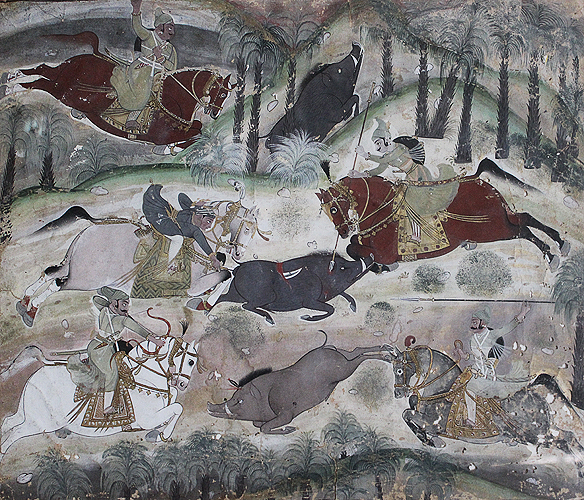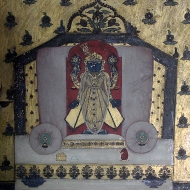
Me: Kotah Palace jaanaa hai. [I want to go to Kotah Palace.]
Auto rickshaw driver: Palace hotel?
Me: Nahin. Sirf palace. Jahaan rajah maharajah rehtey they. [No. Just palace. Where the kings used to live.]
Auto rickshaw driver (confused): Par vahaan toh koi Indian nahin jaataa! Sirf gorey log jaatey hai! [But Indians don’t go there! Only white people do.]
Me: Haan, vahin jaana hai, jahaan gorey log jaatey hai. [My deep gratitude to Caucasians at this point for appreciating the treasures hidden in India’s midst.]
Auto rickshaw driver (laughing): Chalo, aaj yeh bhi dekh letey hai. [Sure, let me see this place too, today.]
It’s chaotic and crowded. I had just got off a rickety bus from Bundi. My train to Delhi, deep into the night, was a good few hours away. The plan was to spend the time in-between devouring the miniature painting frescoes of the Kotah Garh Palace.
Kotah Garh Palace and its collection of miniature paintings
I was not expecting much when I walked into the palace. I had been brainwashed enough in Bundi of Kotah’s lesser role in the scheme of things. “Bundi is the parent city.” “Bundi’s frescoes are the original masterpieces.” All of Kotah was dismissed as a poor copy by the veterans in Bundi’s narrow alleys.
The fact that the palace’s majestic stone walls were “whitewashed” as I walked through the monumental gateways further went against its favour. I almost cringed out aloud in disappointment. But my gloom was short-lived. Down a few corridors, up a string of stone steps, Kotah’s walls assured me “why” it still charmed travellers from far and wide across the globe.
Like Bundi, the walls are covered with frescoes in the miniature style. But the anomaly here is that many appear “framed” and, thus, closer to the format commonly associated with miniature painting. The colours are brighter. The hunting scenes more vivid. The facial expressions more emotive. To top it off, shards of glass and mirror create a 3-dimensional collage effect befitting royal living.
As I wandered around in the silence, I lifted curtains to find doors behind them, opening into pictorial vistas crammed into their four walls. Some were dilapidated. Some still stunning. And before I knew it, a woman guard came to me and gently tapped my shoulder. “Paanch bajney waale hai. Neechey aur hai. Who bhi dekhna. Museum bhi zaroor jaanaa.” [It’s going to be 5 pm. There is more downstairs. Do see them. And do visit the museum too.]
[Note: Click on any of the below images and it will display the set in a gallery with captions. Use the arrows to navigate through the images.]
Bundi-Kotah School of Miniature Painting
Indian miniature painting originated in Persia and the imported miniature painting workshops of Mughal rule. The Hada Chauhan Rajputs, along with other princely states across the sub-continent, were quick to absorb this artistic style into their own aesthetics, each adding their own distinctive personalities to their mix. And thus, took birth the Deccani [in the south], Rajasthani [in the west], and Pahari [in the hills of the north] schools of miniature painting.
Often clubbed together with the Bundi School of Miniature Painting which bloomed on the walls of Bundi’s royal private rooms, the Bundi-Kotah School of Miniature Painting found expression in Kotah. Together, they formed a branch of the Rajasthani school.
There is enough similarity between the two to warrant the conjunction—they both use extremely fine fluid brush strokes and rich colouring to portray multifaceted complex emotions and the vibrancy of nature. Their trademark—hunting scenes against a backdrop of dense forests, flowing rivers, and green fields—are painted using local mineral and vegetable colours. Almost serendipity, wouldn’t you say. 🙂
Kotah: The story of Bundi’s offshoot
Bundi’s offshoot, Kota [christened Kotah] on the opposite bank of the Chambal river was created way back in 1579. Its primary purpose, together with the lands around it, was to serve as a realm for the king’s eldest son. The practice, however, came to a halt in 1624 when Rao Raja Ratan Singh’s second son, Rao Madho Singh and the 1st Rao of Kotah (1631 – 1648), asserted his autonomous rule over it.
Kotah’s fate as an independent state was further sealed in 1631 when Shah Jahan, the 5th Mughal emperor, issued his proclamation recognising its sovereignty. The gesture was the emperor’s way of saying thank you to Rao Madho Singh for his military services to the Mughal empire.
Built in the first half of the 17th Century, Kotah’s crowning glory was, as was the norm back then, its Garh Palace. Every ruler of Kotah, thereafter, added to the edifice right up to the time it was absorbed into free India post-independence. Whether it be the Hathian Pol Gateway or the painted zenanas, concepts were transferred from Bundi’s palace to the newer, bigger, brasher palace in Kotah.
Paradoxically, whilst Bundi, the parent city, remained a small, exquisite, rural town over the ensuing centuries, Kotah, younger, cruder and rougher around the edges, grew to become a large, prosperous, and industrial hub.
But “art” is always authentic, timeless, and pure. Whether it be from Bundi or Kotah in the Bundi-Kotah School of Miniature Painting. As I learnt one summer afternoon in Kotah, despite prejudices. ❤
[Note: Click on any of the below images and it will display the set in a gallery with captions. Use the arrows to navigate through the images.]
Travel tips:
- Timings: 10:00 am – 5:00 pm.
- Ticket: Rs. 100 for Indians; Rs. 500 for foreigners; Photography charges: Rs. 50.
- The Palace’s Maharao Madho Singh Museum [ground floor] has a collection of miniature paintings [on paper], arms and armoury, royal regalia and modes of transport, stuffed animals, and old photographs.
- Getting to Kotah: I took the train from Delhi to Kotah.

![kotah_palace1 The [now white-washed] corridors of Kotah's piece-de-resistance: the 17th Century Kotah Garh Palace.](https://ramaarya.files.wordpress.com/2017/10/kotah_palace1.jpg?w=190&resize=190%2C190&h=190#038;h=190&crop=1)

















Thanks, for nice blog.. we had read these different styles of painting and school in our 12 th standard ..those were limited …
LikeLiked by 1 person
Hello Vinay, thank you for stopping by. Lovely to know that my post has helped you in understanding the Bundi-Kotah school a little better. 🙂
LikeLike
Nice blog i like it
LikeLiked by 1 person
Thank you, Prateek. 🙂 Happy to know you enjoyed the post.
LikeLike
Never knew about this. Thanks for the post, Rama
LikeLiked by 1 person
My pleasure. I was wonderfully surprised here. Hope you are able to visit it one day. 🙂
LikeLiked by 1 person
Let’s hope so. Luck hasn’t been too kind with me of late as far as travel is concerned, Rama
LikeLike
Miniature style painting is a unique style of painting. Of course it has become a challenge for the artists to maintain the ‘purity’ of the tradition in the digital age.
LikeLiked by 1 person
True. Well observed, Durga Prasad. It is indeed a challenge keeping the style true to its authentic self in today’s digitalised art context and mediums. A challenge I hope time succeeds in keeping alive.
LikeLike
I really loved your blog
LikeLiked by 1 person
Thank you, Muskan. 🙂
LikeLiked by 1 person
Beautiful pictures. Looks like natural (vegetable) colour paintings. Rajasthan is a land of beauty.
LikeLiked by 2 people
Yes, they are painted with mineral and vegetable colours. Thank you for stopping by and I am glad you liked the images. 🙂
LikeLiked by 1 person
How beautiful, hope to see it someday ❤
LikeLiked by 2 people
I hope you do too. 🙂 You will love them.
LikeLiked by 1 person
Very nice,, inspirations
http://karsamenak.wordpress.com
LikeLiked by 2 people
Thank you for stopping by, all the way from Indonesia. 🙂 Glad to know you enjoyed the read.
LikeLiked by 1 person
Pingback: the complete travel guide to enigmatic jhalawar | rama toshi arya's blog
Pingback: the complete travel guide to the hidden gems of jhalawar | rama toshi arya's blog
Well Done Mam. You’re Doing Great
LikeLiked by 1 person
Many thanks! Am happy you enjoyed the post. 🙂
LikeLike